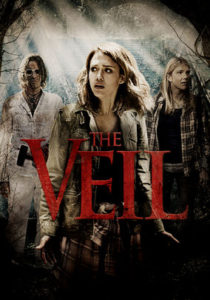 “Thirty years after members of a religious cult committed mass suicide, the lone survivor returns to the scene of the tragedy with a documentary crew in tow.” Through this premise, the 2016 horror-thriller The Veil combines elements of the three most well-known “cult” murder-suicides of the late 20th century. From the Branch Davidians, it features a leader who physically resembles David Koresh and who has a Koresh-like oratory style; there is also an FBI raid that figures heavily in the deaths. Heaven’s Gate contributes a name – the group is Heaven’s Veil – as well as a California location, mattresses for the dying, and an insistence on a new life which is more emphatic than the passing asides made by Jonestown leaders during the mass deaths of November 1978.
“Thirty years after members of a religious cult committed mass suicide, the lone survivor returns to the scene of the tragedy with a documentary crew in tow.” Through this premise, the 2016 horror-thriller The Veil combines elements of the three most well-known “cult” murder-suicides of the late 20th century. From the Branch Davidians, it features a leader who physically resembles David Koresh and who has a Koresh-like oratory style; there is also an FBI raid that figures heavily in the deaths. Heaven’s Gate contributes a name – the group is Heaven’s Veil – as well as a California location, mattresses for the dying, and an insistence on a new life which is more emphatic than the passing asides made by Jonestown leaders during the mass deaths of November 1978.
But it is from Peoples Temple that it takes its greatest influence. The “compound” resembles Jonestown; the positions of the bodies lying on the ground are from photographs of Jonestown; the mixed race and number of children, the remoteness of the area, the description of the tragedy as the largest mass deaths in American history, all resemble Jonestown. The leader is Jim Jacobs, a charismatic, sunglasses-wearing preacher from Indiana who has faith-healing skills. There are even quotes from the death tape as people die.
The combination, though, focuses more upon the gore and the shock of 21st–century horror films than a real consideration of the religious underpinnings of its influences. As with so many other depictions of Jonestown and its progeny, the tragedy continues with the horror of these events serving as nothing more than a device for lazy, uncreative scriptwriters.
Fielding M. McGehee III